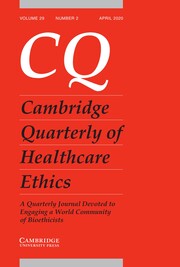The story of bioethics education is an interwoven narrative reflecting our humanistic efforts to engage with moral, ethical, and practical dilemmas. From the early days of emphasis on moral philosophy, the field has taken that initial foundation and moved towards practical applications. In doing so, it has gained strength and a widening scope. That evolution is demonstrated in this Special Section, a collaborative initiative borne out of discussions during our time co-chairing the American Society for Bioethics and Humanities’ affinity group focusing on ethics and humanities educators in the health professions and residency training.
The collection begins with a call to wake us from our “dogmatic curricular slumbers” referring to the need to teach abortion related ethics and policy issues to future doctors in the context of the Supreme Court Dobbs decision. This is followed by a paper that tracks a medical school study trip to Auschwitz to illustrate the power of experiential learning and the role it plays in professional identity formation. Next described is the use of a pathography approach to help medical students better understand mental illness with an emphasis to include the patient’s voice in the clinical practice of medicine. Also addressing the issue of mental health challenges and substance use disorder is an educational framework to better address structural stigma for health care ethics consultants.
The articles in this special issue cover a wide variety of topics and learners. We turn to papers focused on specialty areas: moral distress of Pediatrics residents and an ethics curriculum for Anesthesiology trainees, as well as an interdisciplinary ambassador program to help staff develop tools to identify and seek support for ethical issues that arise while caring for patients with cancer. Other educational challenges came with the new demands and distresses presented by a global pandemic, prompting the development of a hybrid virtual rotation in ethics allowing residents flexibility without compromising high quality education. In addition, the importance of bringing different areas and backgrounds together is emphasized in interprofessional learning education in which students from different professions learn to effectively collaborate to improve health care.
The next series of papers offers practical tools by developing new pedological methods and they point to their impactful benefit on the current medical landscape. Such tools include: the emergence of open access digital educational resources, among them podcasts; a mapping case analysis tool to categorize the flow of clinical cases; a table top exercise enabling learners to implement the knowledge and skills gained through a clinical ethics intensive course; along with a standardized data reporting tool to develop educational content.
In keeping with the increasing emphasis on practical application in bioethics education, the final paper describes a certificate program developed for members of hospital ethics committees, a diverse group with its own specific education needs. The program, designed as a low cost, high-yield option for busy full-time practitioners features an extensive simulated clinical ethics consultation in which learners in the role of ethics consultant, mediate a conflict between family members played by professional paid actors.
As bioethics education has emerged from a theory-focused endeavor to the high wire reality of clinical application, the field continues to gain in strength and momentum. It is the aim of this Special Section to provide information, inspiration, and serve the need of bioethics educators from all perspectives, as a resource for the continuing unfolding of this story.

